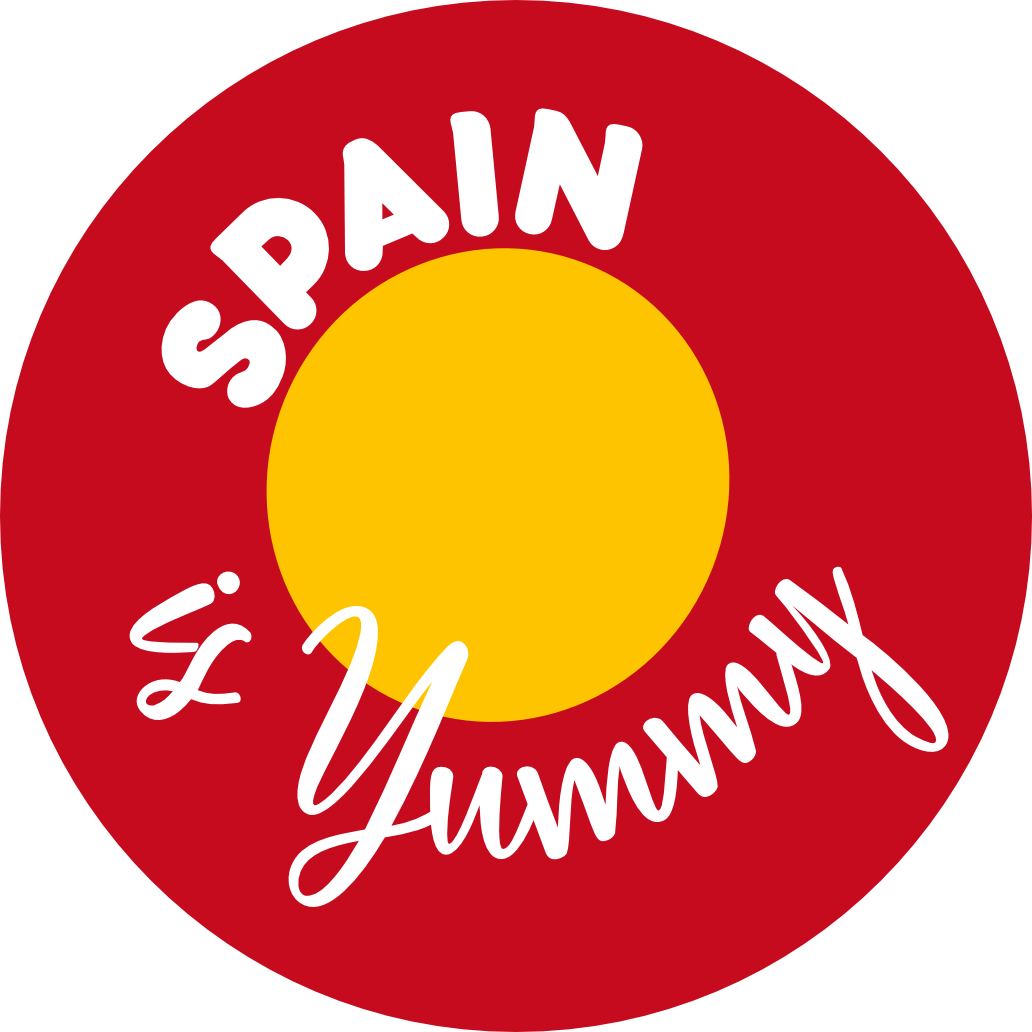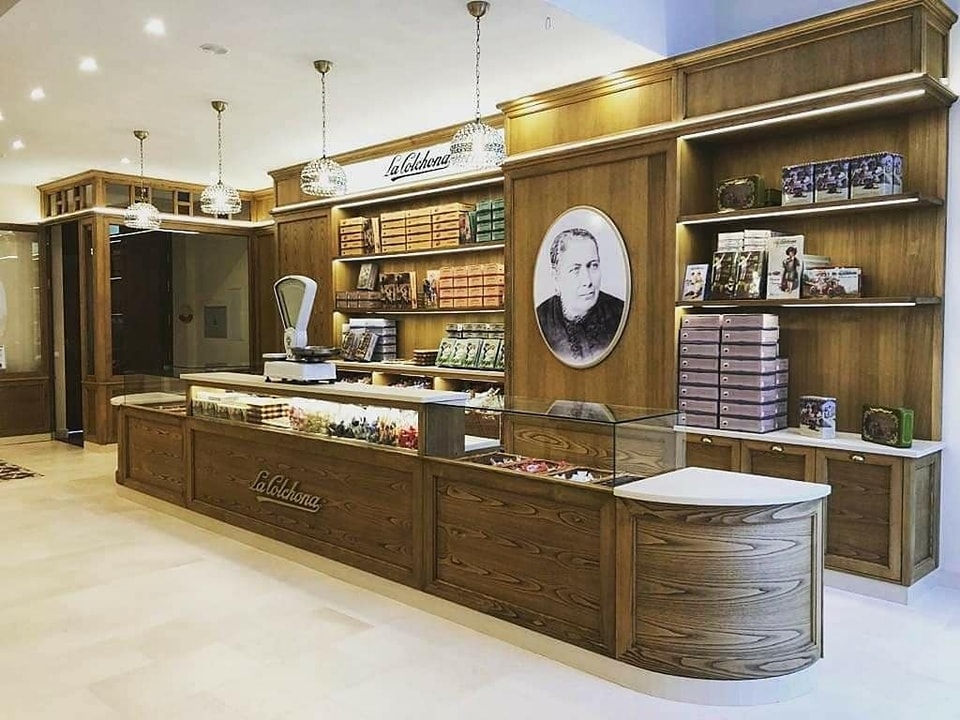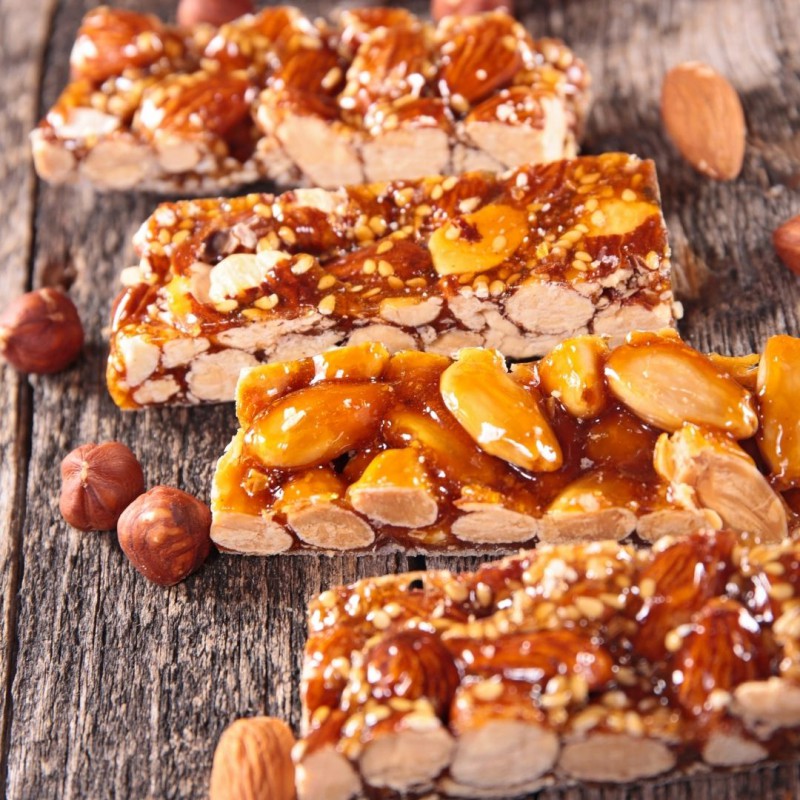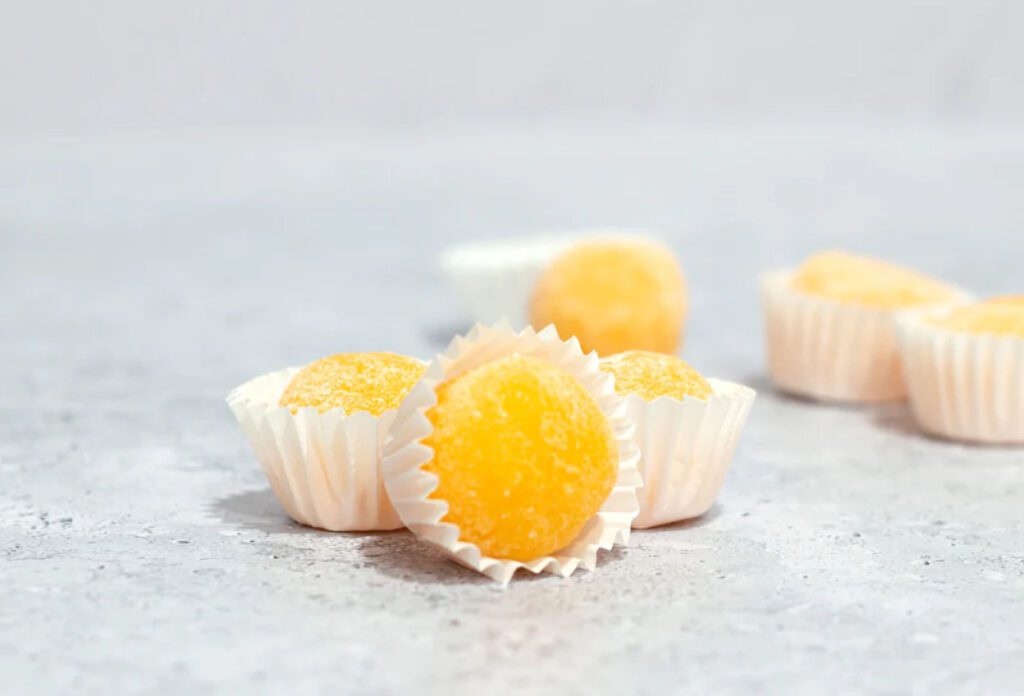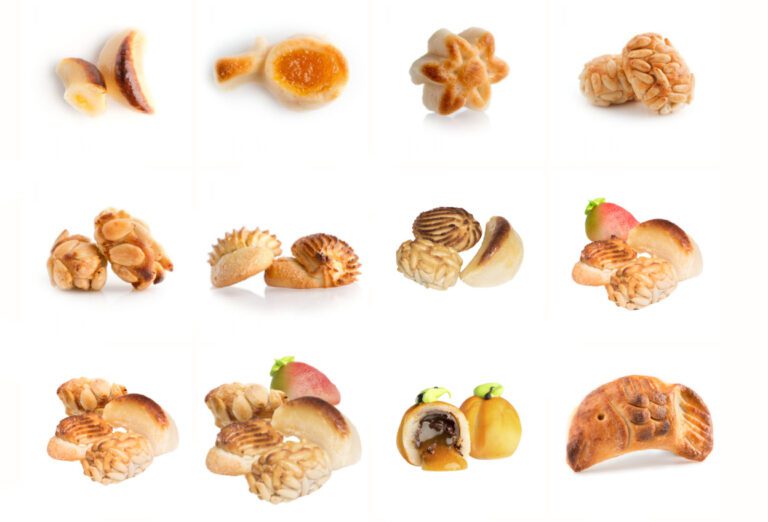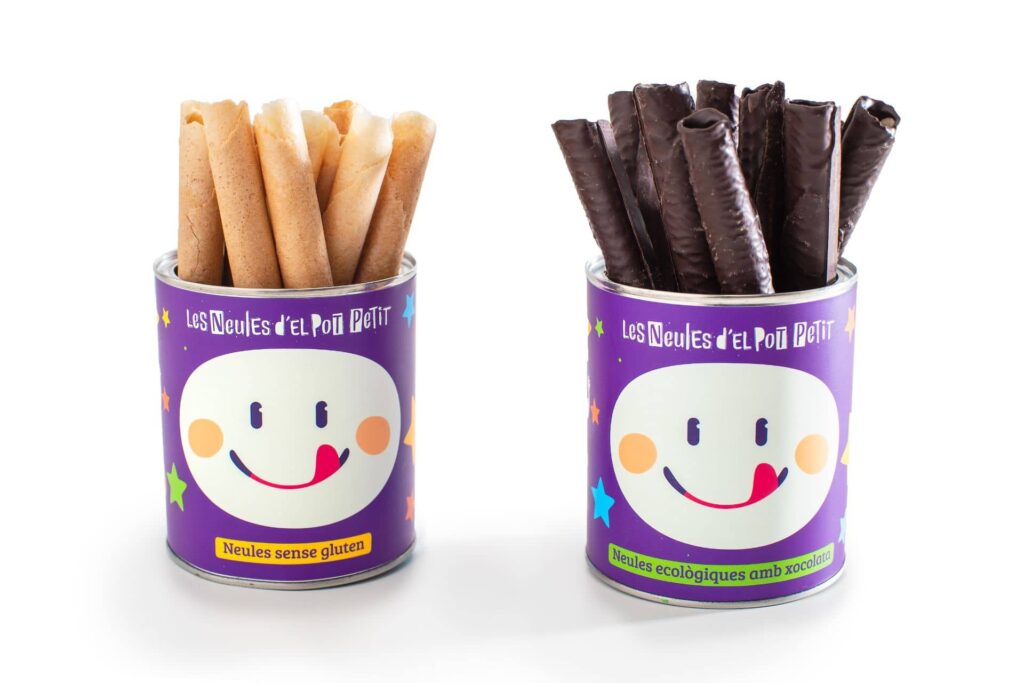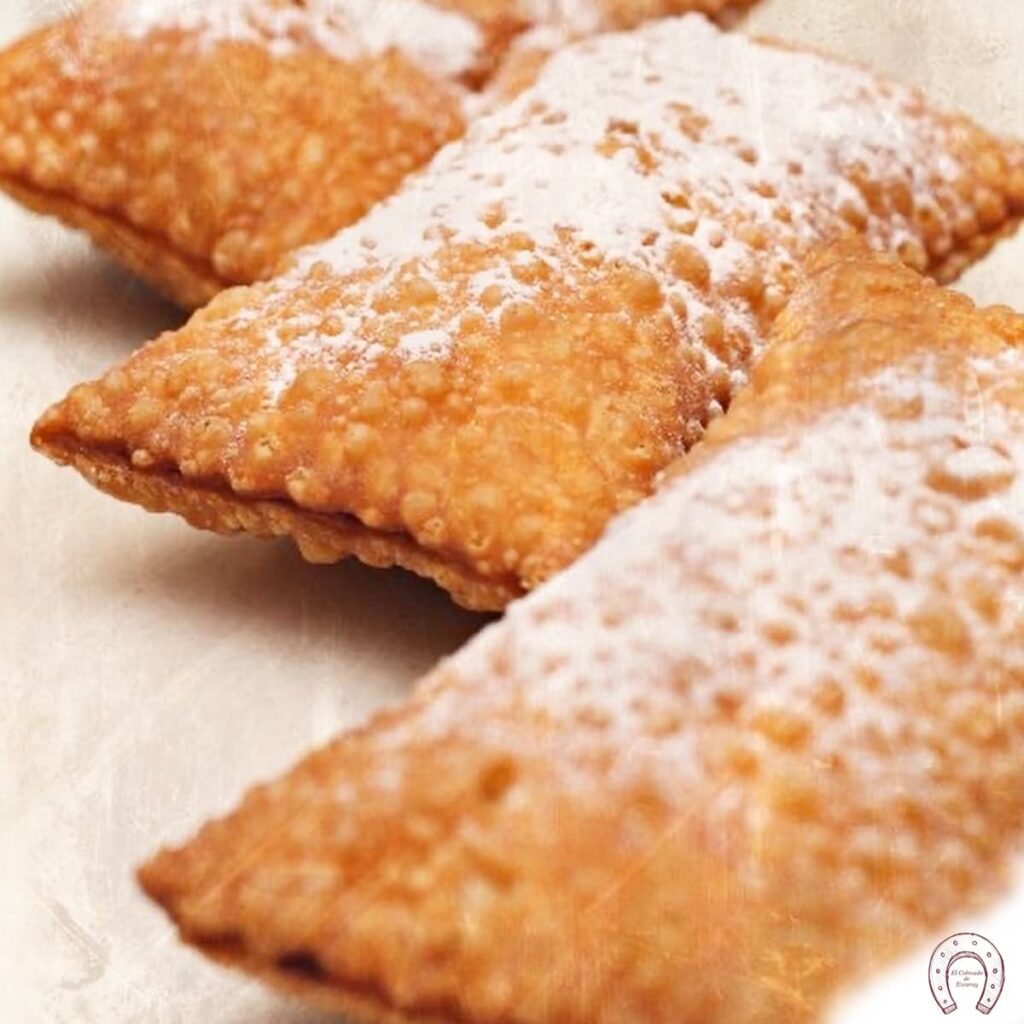Spain has 17 autonomous regions ( Comunidades autónomas ) regions that have many things in common yet celebrate enriching differences between one and the other. Typical Spanish Christmas sweets are no exception. Some of these sweets are exclusive to the Christmas season, while others can be found in patisseries all year around. Depending on where you are in Spain you might want to look for one sweet or another to satisfy your Jingle bell sweet tooth. In this article, I will propose one Christmas sweet for every autonomous region in Spain.
My choices do not represent the most popular sweet in each region, but rather ones that are unique. Most of these sweets can be found almost anywhere in Spain under the same name or a different one. So relax and enjoy the Spanish Christmas sugar rush.
Christmas in Spain
The Christmas season in Spain is a time when food takes center stage. Friends and coworkers gather for Christmas dinners or lunches (Cena o Comida de Navidad) usually in the days preceding Christmas eve. Restaurants are fully booked with their Christmas Menu offerings, fish and seafood prices rocket high, and pastry shops glee smells of almonds and cinnamon. Shelves in food shops are filled with Turrones marzipans, polvorones, mantecados, and all kinds of sweets.
So if I had to choose one Christmas Sweet for each autonomous region, what would that be? If you live in Spain or had been to Spain please share your favorite Christmas Sweet from the regions you´ve been to.


Andalucía: Polvorones
In Andalucía there are so many Christmas sweets that it´s almost impossible to choose one. Everywhere you go there are piles of mantecados, roscos de vino, alfajores ( which are not the same as the alfajores from Argentina), stacks of turrones, and other international Christmas specialties. But my choice for Andalucía, where we live, is solely based on the Christmas craze in our home. By the beginning of November, my kids would be already asking for polvorones. Unlike the very similar mantecados, polvorones are seasonal, and it´s not that easy to find them in such abundance the rest of the year.
What are Polvorones?
Polvorones are soft, compact crumbly sweets made traditionally of wheat flour, sugar, lard, and ground almonds. they are considered a type of mantecado with the main difference being that they must include grounded almonds. Their shape is usually oval, and they are wrapped in opaque paper, which helps to conserve them and makes it possible to enjoy the whole polvoron catching all the crumbles. TRaditional wisdom advises that you squeeze the still wrapped in paper polvorón in your hand before eating it. That way it compacts a bit more and is less likely to crumble on you.
Nowadays polvorones may include other spices and ingredients like cocoa powder, sesame seeds, anise, cloves, and citrus essence.
Where to buy polvorones
You can buy your polvorones practically anywhere in Andalucía during the Christmas season, especially from patisseries and bakeries. You may also buy yours online. FYI, La Colchona bakeshop which dates back to 1850, and whose founder Micaela Ruiz Telléz is considered responsible for perfecting the recipe of mantecadosmaking it possible to sell them far from home, is still open. Other mantecados manufacturers are the prized Felipe II mantecados, although I haven´t seen any polvorones on their website.
Aragón: El guirlache
El guirlache, el turrón de Aragón, or the nougat of Aragón is another Christmas sweet that makes use of the almonds harvested in the autumn. Although it might be found in other Spanish regions, it is most popular in the Aragón region. Guirlache can be enjoyed as a treat on its own, but also may form part of other desserts.
What is guirlache?
It can be defined as an almond and caramel candy, usually shaped into rectangular bars that are never the same size. A variation of guirlache can be prepared, substituting hazelnuts, pine nuts, or peanuts for almonds.
Where to buy guirlache,
If you are in the Aragón region during the Christmas season, you can buy guirlache in almost any traditional bakery, pastry shop, or delicatessen specialized store. You can also buy excellent quality guirlache online.
Cantabria: Torrijas
While in all Spanish territories torrijas are eaten around Easter, in Cantabria they are also profusely enjoyed during the Christmas season gaining a spot in the table with other Spanish Christmas sweets. In Cantabria they are called torrijas, torrejas, or even tostadas, which is quite peculiar since bread, the main ingredient in torrejas, is never toasted during their preparation.
The habit of consuming torrejas at Christmas in Cantabria is not that recent. They are mentioned by José María de Pereda in Escenas montañesas, in his chapter on Christmas Eve in 1864.
What are torrejas:
Torrejas or torrijas are very similar to French pain perdu or the UK Poor Knights of Windsor. The main ingredients are slightly stale bread a couple of days old, milk or sweet wine to soak the bread, sugar, cinnamon, and honey. The bread is soaked in sweet wine or milk infused with whole cinnamon sticks and optionally orange peels. Then it´s coated with the whisked eggs and fried. After that, it´s lightly covered with sugar, or honey diluted with a bit of water. The Internet is full of Torrijas recipes with different variations.
Where to enjoy Torrejas:
During Christmas in Cantabria or Easter in the rest of Spain, torrijas are is easy to find in bakeries, pastry shops, and as a dessert in restaurants. I invite you to add Torrejas to your Spanish Christmas repertoire and try to prepare yours at home.
Castilla y León: Yemas de Ávila
Yemas de Ávila or Ávila yolks, bear the name of the city where this sweet was born. The bakery Flor de Castilla in the city of Ávila was the first to prepare them and sell them to the public in 1860 under the name Yemas de Santa Teresa which is registered as their brand of the original golden yellow sweets.
What are Yemas de Ávila:
One of the most delicate Spanish Christmas sweets made of sugar and egg yolk then shaped into 2cm balls. Sugar syrup is prepared and while still hot egg yolks are added while swiftly stirring to form a homogenous mix. which is then manually shaped into small balls coated with sugar and placed in tiny paper cups.
Where to buy Yemas de Ávila or Yemas de Santa Teresa?
Yemas de Ávila is considered a must-souvenir when you visit the city of Ávila. They are more widely available during the Christmas season but can easily be purchased all year around. The original Yemas de Santa Teresa are prepared so that their shelf life is extended to over a couple of months and thus can be shipped internationally as well.
Castilla la Mancha: Mazapán de Toledo.
During the Christmas season in Castilla La Mancha you can enjoy sweets like marquesitas, nevaditos, enaceitados and suspiros, but my choice had fallen on the famous mazapán de Toledo, or Toledo marzipan.
Marzipan is a sweet that is quite widespread in different European countries. It is believed that it was introduced to Eastern Europe by the Turks, while in Spain it was most probably introduced by the Arabs.
What is Toledo marzipan?
Toledo marzipan is mainly a paste prepared with raw ground almonds emulsified with sugar. The quality of marzipan is determined by the variety, quality, and percentage of almonds used to prepare it. The masterpieces of sweet marzipan that are most sold at Christmas time are the famous marzipan eels ( Aguilas de mazapán) from Toledo.
Where to buy Toledo marzipan:
As its name indicates, you can buy it in Toledo. But it´s so widespread that during the Christmas season you can buy it almost anywhere in Spain. a simple search on the internet for toledo marzipan or mazapán de Toledo yields tens of results of specialty stores from Castilla La Mancha offering authentic Toledo marzipan made of Macrona Almonds from the region of Valencia where they are cultivated in abundance.
Catalunya: Neules
Since the XVIIIth century, when the shape of Neules changed from flat to cylindrical, Neules slowly became a traditional Christmas sweet in Catalan gastronomy together with nougat and marzipan. During the Christmas season in Catalonia, Neules are shared with the family, plain, accompanied by nougat ( turrón), crema Catalana, dipped in chocolate, liquors, or cava.
What are Neules?
Neules are cylindrical-shaped sweet light wafers made mainly of wheat flour, sugar, egg yolks, and butter. It is said their name comes from Latin Nebula, which means fog, referring to its lightness. Its origins are linked to the region’s nuns’ monasteries famous for their sweets.
Where to buy Neules.
During the Christmas season, they are easily found in almost any Christmas market, just like the feria de la Sagrada Familia in Barcelona. To be able to enjoy handmade high-quality neules look for them in bakeries, pastry shops, and specialty shops. In Rupit there´s even a shop called el Neuler that is specialized in Neules of all types. What´s more, a lot of neules manufacturers boasting their use of the original medieval recipe are accessible through their online stores, so you can enjoy neules anywhere you are.
Comunidad de Madrid: Monastery sweets
Being home to the Spanish Capital Madrid, the Madrid region is where you can find almost any Spanish Christmas sweet you can think of. So, instead of suggesting a specific Christmas sweet, I would suggest a route of monasteries. One of the activities enjoyed by locals and tourists. So if you are in Madrid during the Christmas season do visit at least one monastery to enjoy their Christmas sweets.
El Monasterio del Corpus Christi
Located in Plaza del Conde de Miranda in Madrid, is surrounded by the aroma of aniseed , emanating from Spanish Christmas sweets like Mantecados de Jerez, naranjines, sequillos, nevaditos, cookies and tea pastries.
Convento de San Diego
Beatas 7, Alcalá de henares. The nuns of this monatery are are popularly known as “almendreras” in reference to the only but spectacular sweet they make: the “almendras garrapiñadas” or caramelized almonds.
El Convento de las Carmelitas Descalzas
Duque de Alba, 3. Loeches. The specialty of this monastery is fruit compotes, jams, and marmalades prepared with fruit from the convent’s orchard.
El Monasterio de la Inmaculada Concepción.
Abapies, 37, Chinchón. The Clarisas nuns of this monastery prepare a variety of sweets like fried rosquillas, soplillos, almond praline nougat y almond paste with marzipan, and mantecados nevados, prepared with lemon zest, aguardiente liquor, and puff pastry.
El Convento de las Clarisas
Párroco Don Lorenzo, 1. Valdemoro. in this monastery the products are sweet and savory. But since we are in sweet Christmas territory, their sugary repertoire includes chocolate truffles, granny´s almendrados, and flower and heart pastries.
Comunidad Valenciana: Turrón de Jijona
•In Valencia región some of the typical Christmas sweets are anouetes, coca de llanda, rosegons, peladillas, coca Cristina, coca escudellà and yema de Albaida which is the Valencian versión of Yemas de Ávila. But the most famous Christmas sweet in this región is that of Turrón de Jijona, or Jijona nougat. This name refers to the soft nougat manufactured in Jijona in Alicante, and is one of two nougats with protected designation of origin, from the Valencia region. The other one is called Turrón de Alicante ‘
What is turrón de Jijona?
It is a soft almond nougat prepared by mixing toasted milled almonds with cooked honey and sugar. processing and emulsifying the mixture again, then letting it rest to rid it of excess almond oil. And ofcounrese to be called Turrón de Jijona is has to be produced in Jijona, Alicante.
Where can you by Jijona turrón?
On the official webpage of the Jijona regulatory council, the companies and brands complying with the specific requisites of Turrón de Jijona and turrón de Alicante are listed. With links to their websites and online stores. A lot of delicatessen and specialized stores all over Spain offer these two delicious Christmas sweets from the Valencia region.
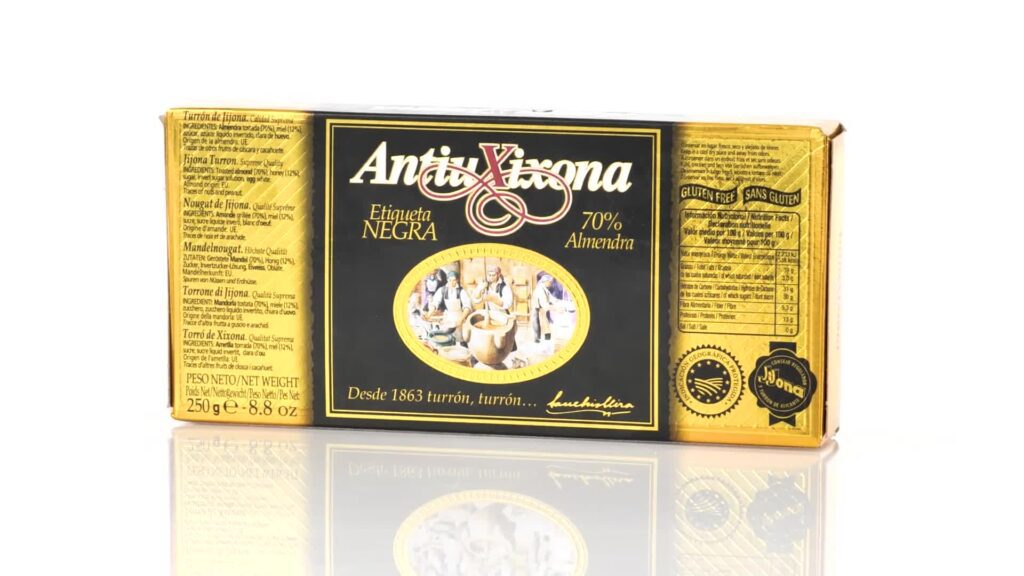

Extremadura: Bollo Turco Jerezano
In Extremadura, some of the main Christmas sweets are Mantecados, fried milk, polvorones, and pestiños. Nevertheless, there is a very specific sweet, called Bollo Turco Jerezano that forms part of the Sweet Christmas tradition in Jerez de los Caballeros.
What is Bollo turco Jerezano?
It is a Christmas sweet with quite a peculiar shape made of ( guess what?!) ground almonds, sugar, eggs, and lemon zest. The mix is shaped over a waffle, baked, then decorated with sugar and water. It is one of the oldest sweet recipes of the Extremadura gastronomy.
Where can you buy Bollo turco Jerezano?
If you donñt have the time to visit Jerez de Los Caballeros you can always order yours online wherever you are in Spain from some specialized online stores like the pastry and bakery called Canela in the same town.
Galicia: Bandullo
This is us helping save a Typical Galicia dessert from extinction. Bandullo in Spanish means entrails of cow, ram, or pig. Traditionally bandullo was the result of using pigs entrails or bladder to give shape to a sweet bread pudding.
So what is Bandullo?
Nowadays the Galicia-style bread pudding bandullo had survived without the entrails mold, with bread, milk, sugar, and lard being its main ingredients often aromatized with cinnamon. Don´t you think it would be cool if it was still presented in a pig’s bladder?
Where can you enjoy bandullo?
As I commented Bandullo is almost extinct, although there are some recipes circulating on the internet. Will you help revive this traditional practical sweet from Galicia? Are you from Galicia and your family prepares Bandullo during Christmas? It would be great if you could share your recipe with us to get Bandullo back among the traditional Spanish Christmas sweets list.
Islas Baleares: Cuscussó
At the beginning of the 10th century, the Island of Menorca was occupied by the Muslims and after four centuries of domination, they left their mark. Cuscussó is part of that heritage. A sweet that the housewives in the paste prepared from what they had on hand and kept in the pantry, as it could not be otherwise.
What is Cuscussó?
Cuscussó is a sweet that lies somewhere between marzipan and sweet almond couscous depending on the town where it is prepared. In Ciutadella cuscussó is more compact. It is cut with a knife and is more similar in texture to marzipan. In other towns, on the other hand, it is a crumbled dessert, more similar to couscous. It is eaten with a spoon and can be eaten either as a dessert, or used as stuffing for turkey or chicken, or even as a garnish for a meat dish.
Cuscussó has endured in the memory of the Menorcan’s and has been elaborated with very few variations with respect to the original recipe inherited from the Muslims. The main ingredients are almonds, pork fat, bread, and honey or sugar. To today’s cuscussó is usually decorated with candied fruits, raisins, pine nuts, etc.
Where to have cuscussó.
I personally haven´t tried this sweet. I found some references to Menorcan restaurants that at some point had it on their menus, although it seems fairly popular in the domestic domain. So if you are in Menorca, make friends and get invited to a Christmas dinner. If you know a pastry shop that sells this sweet during the Christmas season please share! For the time being, I´ll put it on my to-do list and try to prepare it at home! I will leave you with this reference from the Repsol culinary guide and a recipe for turkey stuffed with Cuscussó
Canary Islands: Las truchas de batata
If there is a typical dish on the Canarian Christmas table, it is the traditional sweet potato trout, although they are also prepared at any time of the year. The most commonly cooked and consumed trouts are those filled with sweet potato, but it is also common to fill them with angel hair pumpkin, or even with some cream or chocolate. Just in case you wondered, no, it does not include the fish trout! Sweet potato was imported from central and south America. This Canarian desert reflects the role played by the islands as a strategic point connecting Spain and Europe with South America
What are truchas de batata ( Sweet potato trouts)?
The word trouts here refers to sweet patties with different fillings, in this case, they are patties filled with a mix of sweet potatoes, sugar, processed toasted almonds, and raisins. Filling the circular pastry, it is sealed into half circles, deep fried, and dusted with powdered sugar once they have cooled. FYI, Sweet potatoes in Spanish are called batata or boniato, so truchas de boniato are the same as truchas de batata.
Where to buy Truchas de batata.
If you are in the Canary islands, especially during the Christmas season, most traditional and local pastry shops will be offering this delicious Christmas sweet. If you are not planning an island trip, then you can definitely prepare this relatively easy dessert at home.
La Rioja: fardelejos
Fardelejos pastries are originally from Arnedo, La Rioja. It is almost impossible to imagine a tray of sweets in Arnedo without Fadelejos. You will again, find almonds as the protagonist in this recipe. Besides being the typical sweet of popular and patron saint festivities, like the juanguila, Christmas, and easter, the fardelejo pastries can be found all year round, and are also eaten as breakfast or dessert.
What is Fardelejo?
It is a sweet of Arab origin that began to be produced in the town of Arnedo in the ninth and tenth centuries. It consists of a very thin puff pastry with a filling similar to marzipan but much lighter, composed of egg, ground almonds, lemon zest, and sugar. The pastries are fried and served covered with powdered sugar Fardelejos are characterized by their rectangular shape with a raised edge.
Where to buy Fardelejos?
Ferdelejos are hyper-popular in the town of Arnedo and are sold throughout the Rioja province as a typical product. So, if you are in La Rioja during Christmas please do not run to the closest supermarket to buy a box of chocolates or a panettone, but rather look for a local pastry shop and enjoy some Fardelejos and other local Christmas delicacies.
Murcia: Cordiales Murcianos.
Cordiales are a magnificent Christmas dessert, typical of the Levantine lands, more specifically Murcia region. Its main ingredients are almonds and angel hair pumpkin. The arrival of cordiales to the house means that Christmas is approaching. Cordiales, like so many other traditional sweets, were invented within the walls of a convent. But its popularity has spread throughout the country.
What are Cordiales?
Murcian cordiales are delicious marzipan pastries, with angel hair pumpkin filling. Marzipan pastry is prepared with almond flour, sugar, lemon zest and eggs. The pastry is divided into smaller portions that are filled with angel hair pumpkin filling and shaped into rounded cones, that identify Cordiales.
Where to buy cordiales?
Murcia pastry shops, especially during the Christmas season, and even some shops online from all over Spain offer different versions of Cordiales, like the Clarisas convent in Seville.
Navarra: Cuajada de Ultzama
Although Ultzama curd is not at all a specific Christmas dessert, it is one of the most famous sweet culinary creations from the Navarra province. And definitely forms part of the desserts you can enjoy during the Christmas season nowadays.
The Ultzama Valley is an area in the northern part of Navarra province, a land of shepherds and placid nature. This delicious dessert is prepared using milk from the sheep of the valley grazing nearby.
What is cuajada de Ultzama / Ultzama curd?
Sugar is added to sheep milk, then it´s boiled. Traditionally the shepherds heated their milk by dropping hot stones in the jug, which gave it its characteristic toasted taste. Still today hot stones are added to the milk used to prepare the Ultzama cuajada to maintain the taste as close as possible to the original.
Once the stones are removed, the rennet is stirred in, then it is left still for about 10 minutes, after which it is refrigerated. Traditionally a dry piece of lamb stomach was used as rennet, but today liquid rennet is used. When the curd is ready you can enjoy it with honey and walnuts or as a part of a dessert.
Where to buy Cuajada de Ultzama?
In Ultzama valley, every second weekend Milk Curd Day/el día de la cuajada is celebrated. This is a fantastic opportunity to enjoy freshly made Ultzama curd and learn how to prepare it yourself. Ultzama curd can also be found in some specialty shops, and traditional markets and you can even buy your combo of sheep’s milk with rennet to prepare your own.
País Vasco: Intxaursaltsa
It does not have almonds, it is not bite-size, it cannot be cut and it´s so typical during Christmas in the Basque region, Specially Guipuzcua. Intxaursalsa means the sauce of walnuts. Which is quite descriptive of this traditional Christmas dessert.
The walnut has been an essential part of the Basques for at least 200 years. In December, when all the villagers would come down to the city to pay their tithes, they would also sell their produce and would stockpile things like dried cod, walnuts, fresh milk, corn, sugar (if they could afford it), and honey. Part of these ingredients was used to cook the intxaursaltsa.
What is Intxaursaltsa?
The traditional recipe of Intxaursaltsa included milk, walnuts, honey or sugar, and crumbled salted cod. Nowadays, cod is no longer part of the recipe and the preparation is, rather, a nut cream without chunks. It is a creamy dessert with a consistency similar to a custard, whose final texture depends mainly on the amount of nuts used and the cooking time.
Where to enjoy Intxaursalsa?
In Basque homes or in restaurants from the region in it´s classical Christmassy recipe. Although nowadays you can find variations of intxaursaltsa in the preparation of ice creams and other desserts. It´s very easy to prepare at home. Grounding the walnuts it takes around 10 minutes to cook, so have a Christmas a la Vasca and bon appetit.
Principado de Asturias: El escaldao
Escaldao, Asturian Christmas dessert par excellence, is a simple dessert, prepared during Christmas by the grandmothers of the poorest houses and continues to surprise those who try it. A sweet that is similar in appearance to the soft almond nougat, but without almonds. For this reason, it was known as the nougat of the poor. Outside Asturias, it is a little-known dessert, but it is a delicacy that you should not miss, at least one Christmas in your life.
What is Escaldao?
Escaldao, the nougat of the poor is a dessert characterized by its traditional flavor, its sweetness, tender texture and yellow color. Escaldao is the Asturian version of bread pudding with dense consistency that allows it to be shaped similar to soft almond nougat. Although some recipes show a less solid preparation eaten with a spoon.
Boroña bread which is prepared with wheat and corn flour is the main ingredient of escaldao. The traditional recipe used lard, but nowadays, it is made with butter, sugar, water, honey, and a lot of patience to stir everything while cooking until it has the right consistency.
Where to enjoy Escaldao?
Nowadays it can be eaten at some local traditional festivals and fairs. And maybe because of its humble homey preparation you have a better chance if you try to prepare escaldao or escaldáu as they would say in Asturias at home. The taste of the traditional is back in fashion!
The King of Christmas sweets in Spain
El Roscón de reyes / the three kings cake
In Spain, one cannot imagine Christmas without Roscón de Reyes!
As the three kings day approaches, Spanish families rush to celebrate the closure of Christmas festivities, presents are ready, meals are planned, and while all sorts of details might vary from home to home, The Roscón de Reyes on the 6th of January, three kings day, is the king of Spanish Christmas Sweets. You´d find families cueing the day before to pick up their Roscón de Reyes from bakeries or turning on their ovens to home-bake theirs. And you know almost everybody in Spain would have Roscón de Reyes on the 6th of January if not for breakfast, then for a snack.
Even though the Kings cake in Spain is a very extended tradition, it was the Romans who brought it into existence, revived by the French in the XIth century, and imported to Spain by Felipe V during the XVIIIth century. Turning the Roscón de Reyes from a pagan celebration of the winter solstice to a Christian tradition to celebrate the epiphany.
What is Roscón de reyes?
It is a typical and traditional dessert for the Three Kings Day meal. It consists of a sweet round bun that imitates a crown, covered with candied fruit that resembles the crown jewels and filled with cream, truffle, or cream.
Inside the king’s cake, you will find hidden small ceramic figurines and a dry bean. Although sometimes the ceramic figures completely replaced the bean. A Spanish tradition is that the one who finds the bean pays for the roscón. In all cases, be careful while enjoying the roscón, for you don´t want to end up at the dentist on the 7th of January.
No need to tell you that you can buy yours before the three kings day almost in any bakery or pastry shop if you book yours in advance.


Links and references:
- https://identidadaragonesa.wordpress.com/2017/12/14/el-guirlache-el-turron-aragones/
- https://www.eldiariomontanes.es/cantabria-mesa/cantabria-disfruta-navidad-20211228212601-nt.html
- De pereda, José María. Ecenas montañesas, La noche da Navidad. Imprenta de A. de San Martín y Agustín Jubera, 1864.
- Las yemas de santa teresa. http://www.tierradesabor.es/
- https://elblogdeceleste.com/mazapan-obrador-santo-tome-toledo/
- Neules, un postre catalán con historia.
- Los dulces navideños de los conventos en Madrid
- Geografía del bandullo.
- Cuscussó by Tiberis.
- More info in Intxaursaltsa by El comidista.
- El valor de la sencillez Guía Repsol.
